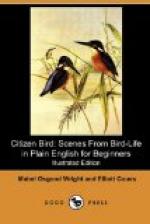“Yes, I remember,” answered the Doctor. “All the Tanagers of our country have pretty much the same habits. Even if we had found the nest we might have mistaken it for a Scarlet Tanager’s. Those I have seen in the Museum are quite similar, built of twigs and pliant stems, and lined with fine rootlets. The position of the nest, saddled as it is on the horizontal limb of a tree, is very similar, and you could hardly tell the eggs apart.
“But come, children, you must be tired by this time, and hungry too. Let us go to supper, and see what Mammy Bun has cooked for us this evening. You stay too, Rap.”
The Louisiana Tanager.
Length about seven inches.
Adult male: rich yellow, with black wings, tail, and middle of the back; the wings with two white or yellow bars on each; the whole head crimson.
Female: not very different from the female Scarlet Tanager.
A handsome and useful Summer Citizen of nearly all that great part of the United States which was once called Louisiana.
A member of the same guilds as the Scarlet Tanager.
CHAPTER XVI
A TRIBE OF WEED WARRIORS
(Containing both Soldiers and Quakers)
“A new family? Soldiers and Quakers? What does that mean?” asked Nat. “I thought my jolly yellow bird with the black cap came next.”
“His family does come next—the Finch family. You must hear a little about that first, and let your American Goldfinch take his turn with his brothers and cousins, for Rap’s Rose-breasted Grosbeak belongs also in this family.”
“You say my bird is called American Goldfinch. He is such a bright yellow that gold is a good name for him, but what does ‘Finch’ mean?”
“Finch, as I said, is the name of the great family to which he belongs. It is the very largest family in Birdland, and members of it live in almost all parts of the world. All kinds of Finches and Sparrows belong to it, and so do Grosbeaks and Buntings, as well as the Canaries that we keep for pets. There are about five hundred and fifty different kinds of them.
“The birds that you have been studying thus far, from the Bluebird, Robin, and Wood Thrush to the Tanagers, belong to several different families and are chiefly insect-eaters, taking various fruits and berries in season, it is true, but making insects their regular diet. Insects are not hard for any bird to eat, and so the bills of these birds do not have to be very stout or thick—some, indeed, are very thin and weak, like the Brown Creeper’s.
“But the habits of the Finch family are quite different, and their beaks also. They are true seed-eating birds, and their beaks are short, stout, and thick—cone-shaped it is called, like that of the White-throated Sparrow you learned about one day. This enables them to crack the various seeds upon which they live at all times except in the nesting season, when few seeds are ripe. During this time they eat a variety of insects, and feed them to the young birds; for young birds must grow so rapidly, in order to be strong enough for the autumn journey, that they require more nourishing food than seeds.




